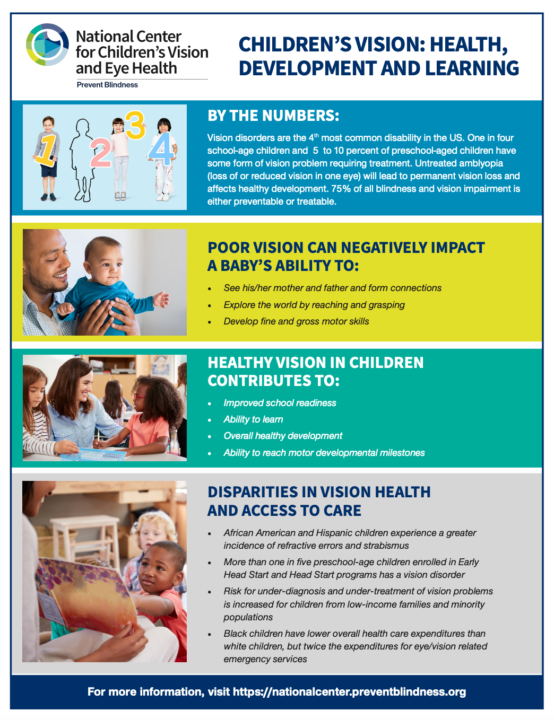Access, equity and education about common eye health issues are important
Many parents may not think twice about their child’s vision. They may assume that regular checkups with a pediatrician and school screenings are sufficient. Their concerns may be limited to whether or not their child needs glasses. Yet eye care providers know that early detection, diagnosis, and treatment of a vision disorder—starting with comprehensive screenings from an optometrist or ophthalmologist—is critical to a child’s long-term vision health. June is Child Vision Awareness Month. Here are some facts and resources to inform your patient education and outreach efforts.
Not enough access to timely vision screenings for children
As of 2020, only 40 states mandated some type of vision screening for school-age children and 26 states required vision screening for preschool-age children, according to the report, “Children’s Vision and Eye Health: A Snapshot of Current National Issues 2nd Edition,” from the National Center for Children’s Vision and Eye Health at Prevent Blindness (NCCVEH). Many children in the U.S. do not receive timely vision screenings or access to professional eye care. The COVID-19 pandemic and school closures only worsened this fact.
While about 1 billion children worldwide have vision impairment, many do not receive timely vision screenings or professional eye care.
According to the World Health Organization (WHO), an estimated 1 billion children have vision impairment. The majority of these children have uncorrected refractive error (URE), including significant near-sightedness, far-sightedness, and astigmatism. Blindness resulting from URE and other causes has been diagnosed in 1.4 million children, according to the report, which also noted, “URE in infants and preschool-age children are associated with clinically identified deficits in cognitive and visual-motor functions that may, in turn, have a negative impact on school readiness.”
Equity and vision
The 2020 NCCVEH report also includes an expanded section on equity titled “Equity Matters in Vision.” This is significant because the U.S. population has become much more diverse.
The multiracial population in the U.S. grew 276% from 2010-2020. Black, Hispanic and Asian children have higher incidences of refractive errors.
- The 2020 Census found that the multiracial population grew 276% from 2010, and included nearly 34 million people in 2020.
- The Hispanic or Latino population, which includes people of any race, grew 23% during that decade, to just over 62 million in 2020. The Asian population was 24 million.
- Refractive errors make up 70% of decreased visual acuity in Asian and non-Hispanic White children, according to the 2020 NCCVEH report.
- Black or African-American and Hispanic children have a greater incidence of refractive errors and strabismus.
- Non-Hispanic children aged 0-17 years whose primary language at home was not English had the lowest percentage of vision testing as compared to children in homes where English or Spanish were spoken.
Prevent Blindness and the National Optometric Association (NOA) partnered to launch “A.C.H.I.E.V.E: All Children’s Health Initiative for Eye and Vision Excellence,” a program that seeks to raise awareness, specifically among minority parents, about the importance of healthy vision and its connection to learning. Shareable social media images and communications in English and Spanish are available to download for free.
Common vision disorders in children
In addition to promoting the importance of vision screenings and targeting specific patient populations in your outreach and education, it’s a good idea to raise awareness about common vision disorders in children. Sharing these videos on your website, social media pages, and patient emails is one way to do that.
Amblyopia, sometimes called “lazy eye,” is the most common cause of vision loss in children.
Strabismus, or misalignment of the eyes, occurs in up to 4% of children under the age of 6. In addition to vision loss, risks include a negative impact on a child’s emotional health, social relationships, and self image.
Refractive errors are the most common vision disorders in children, including myopia (“nearsightedness”), hyperopia (“farsightedness”), and astigmatism (irregular shape of the front surface of the cornea). In particular, myopia is a growing concern for young patients, with rates increasing during the COVID-19 pandemic.
Common vision disorders in children include myopia, which has increased significantly during the pandemic.
Encourage parents to schedule an eye exam for their child, and make sure they know that most preventative eye care services, such as annual exams and vision testing, are often covered by their insurance plans.
Read one more: 5 Eye Health Misconceptions to Clear Up in 2022
Subscribe to the Rendia Connection for the latest patient engagement and education news, insights and resources!


